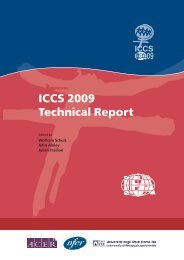International civic and citizenship education study - iccs - IEA
International civic and citizenship education study - iccs - IEA
International civic and citizenship education study - iccs - IEA
- TAGS
- civic
- citizenship
- iccs
- www.iea.nl
Create successful ePaper yourself
Turn your PDF publications into a flip-book with our unique Google optimized e-Paper software.
Contextual Framework<br />
Classification of contextual factors<br />
A <strong>study</strong> of <strong>civic</strong>-related learning outcomes <strong>and</strong> indicators of <strong>civic</strong> engagement needs to<br />
be set in the context of the different factors influencing them. Young people develop their<br />
underst<strong>and</strong>ings about their roles as citizens in contemporary societies through a number of<br />
activities <strong>and</strong> experiences that take place within the contexts of home, school, classrooms, <strong>and</strong><br />
the wider community.<br />
It is therefore important to recognize that young people’s knowledge, competencies,<br />
dispositions, <strong>and</strong> self-beliefs are influenced by variables that can be located at different levels<br />
in a multi-level structure (see a similar conceptual view in Scheerens, 1990). The individual<br />
student is located within overlapping contexts of school <strong>and</strong> home. Both contexts form part<br />
of the local community that, in turn, is embedded in the wider sub-national, national, <strong>and</strong><br />
international contexts. The contextual framework for ICCS distinguishes the following levels:<br />
• Context of the wider community: This level comprises the wider context within which schools<br />
<strong>and</strong> home environments work. Factors can be found at local, regional, <strong>and</strong> national levels.<br />
For some countries, the supra-national level might also be relevant as, for example, in<br />
member countries of the European Union.<br />
• Context of schools <strong>and</strong> classrooms: This level comprises factors related to the instruction<br />
students receive, the school culture, <strong>and</strong> the general school environment. 5<br />
• Context of home environments: This level comprises factors related to the home background<br />
<strong>and</strong> the social out-of-school environment of the student (for example, peer-group<br />
activities).<br />
• Context of the individual: This level includes the individual characteristics of the student.<br />
Another important distinction can be made by grouping contextual factors according to those<br />
related to either antecedents or processes:<br />
• Antecedents are those factors that affect how student learning <strong>and</strong> acquisition of <strong>civic</strong>related<br />
underst<strong>and</strong>ings <strong>and</strong> perceptions take place. Note that these factors are levelspecific<br />
<strong>and</strong> may be influenced by antecedents or processes at a higher level. For example,<br />
<strong>civic</strong>-related training of teachers may be affected by historical factors <strong>and</strong>/or policies<br />
implemented at the national level.<br />
• Processes are those factors related to <strong>civic</strong>-related learning <strong>and</strong> the acquisition of<br />
underst<strong>and</strong>ings, competencies, <strong>and</strong> dispositions. They are constrained by antecedents <strong>and</strong><br />
influenced by factors relating to the higher levels of the multi-level structure.<br />
Antecedents <strong>and</strong> processes are factors that shape the outcomes at the level of the individual<br />
student. Learning outcomes related to <strong>civic</strong> <strong>and</strong> <strong>citizenship</strong> <strong>education</strong> at the student level also<br />
can be viewed as aggregates at higher levels (school, country) where they can affect factors<br />
related to process. For example, higher levels of <strong>civic</strong> underst<strong>and</strong>ing <strong>and</strong> engagement among<br />
students can influence the way schools teach <strong>civic</strong> <strong>and</strong> <strong>citizenship</strong> <strong>education</strong>.<br />
Figure 3 illustrates which contextual factors might influence the learning outcomes of <strong>civic</strong><br />
<strong>and</strong> <strong>citizenship</strong> <strong>education</strong>. The (double-headed) arrow between processes <strong>and</strong> outcomes signals<br />
a reciprocal relationship. It is important to emphasize that “feedback” occurs between <strong>civic</strong>related<br />
learning outcomes <strong>and</strong> processes. For example, students with higher levels of <strong>civic</strong><br />
knowledge <strong>and</strong> engagement are those students most likely to participate in activities (at school,<br />
at home, <strong>and</strong> within the community) that promote these outcomes.<br />
5 Because of the sampling design for ICCS, school level <strong>and</strong> classroom level cannot be disentangled. Generally, only one<br />
classroom is selected within each sampled school.<br />
30 ICCS ASSeSSment FrAmework

















